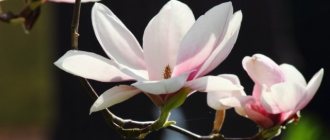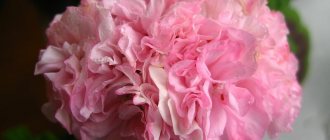Home rose (Rose) is a beautiful flowering shrub from the Rosaceae family .
One of the oldest plants. In the “History” of Herodotus (5th century BC) roses from the luxurious gardens at the palace of King Midas are mentioned. The flower has been grown indoors since the 19th century. House rose is a perennial plant, grows up to 65 cm. Compact bushes with a height of 15 cm are popular and convenient for indoor growing . With good lighting and sufficient moisture, it develops intensively. It blooms starting from the end of March, up to 3 times a year for 2.5 weeks.
In autumn, the bush prepares for hibernation and does not bloom as luxuriantly as in spring, but autumn flowers also delight with their elegant appearance and delicate aroma. With good additional lighting, winter flowering is possible.
| Average growth rate. |
| Blooms starting from the end of March, up to 3 times a year for 2.5 weeks |
| The plant is grown with little difficulty. |
| Perennial. |
Useful properties of domestic rose
Home rose is a valuable raw material for the preparation of medicinal products that improve the functioning of the entire body. Petals are a storehouse of vitamins and minerals. Infusions, decoctions, ointments, teas, and extracts are prepared from them. Used in cooking and winemaking.
Rose oil improves immunity, restores cells, and is used in cosmetology and perfumery. Inhaling the aroma calms and relaxes. The contemplation of a blooming rose evokes aesthetic pleasure.
Botanical description
Rose (Rosa) is a beautiful flowering shrub that belongs to the Rosaceae family. There are high (50-70 cm), low (10-30 cm) and medium (30-50 cm) shrubs .
Most varieties of indoor roses are heat-loving, but there are also varieties that are not picky about temperature conditions.
The shoots of the rose are straight or arched, covered with thorns. The leaves are compound, carved at the edges, imparipinnate. Flowers with a double perianth have a variety of sizes - from 1 to 16 cm in diameter. They can be either single or collected in inflorescences. Each flower contains many stamens and pistils.
The variety of colors is amazing. This plant has a huge number of shades: white, pink, yellow, purple, pink, scarlet, green. Roses are also famous for their pleasant aroma .
Indoor roses will delight you with their flowering if you provide them with good lighting, careful watering and timely pruning. Cut flowers can last in a vase for 5 to 10 days.
Caring for roses at home (briefly)
The rose develops well at home if the conditions of its maintenance are met.
| Temperature | In summer – no higher than + 26°C, in winter – cooler, within + 6 – 16°C. |
| Air humidity | The average, 50%, is maintained by spraying the undersides of the leaves. |
| Lighting | Allows direct sun for several hours a day. |
| Watering roses | When the soil dries out by 2.5 cm - in winter - 1, and in summer - 2 - 3 times every 7 days. |
| Priming | Neutral or slightly acidic flower soil; independently prepared from sand (perlite), peat and humus (1: 2: 2). |
| Feeding and fertilizer | From spring to autumn - complex liquid fertilizers after watering (once every 14 days), you can use organic matter. |
| Transplanting roses | When the roots fill the pot; young bushes - every year, in a new pot larger (2.5 cm) in size, adults - as they grow, in the same pot, cutting off the roots. |
| Reproduction | From August to March - by rooting the tops or cuttings from the middle parts of the shoots in a mixture of sand and peat (temperature + 18 - 20 ° C). |
Caring for a rose is simple, but there are some peculiarities in growing roses. To get beautiful bushes, they are pruned regularly - after flowering and in the spring. In summer, the plant benefits from air baths; it is taken out into the garden or onto the balcony (choose a place protected from drafts).
Step-by-step instructions for properly watering a plant in a pot
- It is necessary to collect water in containers and leave it to settle. You can also draw water from the filter and leave it so that its temperature rises to room temperature.
- We place a tray under the pot, which should already be there; check whether the pot has a drainage system.
- The amount of water is determined by the diameter of the pot; it is important that the soil is moist, but not flooded; it should not squelch from excess water.
- After 10-15 minutes, you need to drain the spilled water into the water pan; this is the water that the plant does not need and will be unnecessary.
- In summer we water the plant once every one or two days, in winter we reduce watering to once every five to six days.
- We also fertilize once a week in the summer, and in winter we reduce it to once a month - one and a half.
Caring for roses at home. Details
The flower, which has been decorating southern gardens for thousands of years, has been successfully cultivated as a houseplant for the last 200 years. A rose at home will develop harmoniously if it is surrounded with attention and care.
Home rose blooming
The blossoming of a rose is a beautiful and long-lasting spectacle.
Long stems adorned with glossy green leaves with jagged edges produce delicate flowers with velvety petals in a variety of colors. The domestic rose is an unapproachable beauty, protecting its charm, covering its stems with thorns. But this protection does not interfere with admiring the beauty of the plant and enjoying its fragrance. The flowering of the bush begins at the end of March and occurs in waves. For experienced gardeners, the rose blooms three times during the year.
To stimulate the appearance of new flower buds after the end of flowering, the shoot with peduncle is shortened by 7–10 cm or faded flowers with peduncles are cut off. Soon new flowers appear at the cutting sites. In autumn, fewer of them are formed, and they are smaller in size than spring roses. To ensure that the home rose blooms in winter, additional bright lighting is installed.
Rose dormant period
The domestic rose blooms luxuriantly during spring and summer, faithfully giving away its strength. But like any living creature, she needs rest. The dormant period of roses falls in winter. At this time, it stops growing and does not bloom, sometimes losing leaves.
In order for the plant to rest and fully regain its strength, it is kept in a cool room at a temperature of about 0°C, after shortening the shoots to 15 - 10 cm.
They do not stop watering, but do it no more than once every 7 days.
Temperature
The domestic rose is a delicate flower. In order for the leaves to be elastic and the rose to bloom beautifully, home care requires observing the temperature regime. The plant tolerates coolness much more easily than heat. At temperatures above + 26°C it can shed leaves or buds.
To cool the bush, it is sprayed. In winter, the flower can be kept on an insulated loggia or simply brought closer to the window glass. The home rose tolerates temperatures from + 6 - 16°C well. At this time, watering is reduced to avoid root rotting. It is important to regularly ventilate the bush, but it should be kept away from drafts.
Spraying
Home rose is responsive to spraying.
The procedure is carried out with settled lukewarm water or a fertilizer solution (you can take “Cascade”). Spraying is useful for the prevention of some diseases of roses, as foliar feeding and for maintaining air humidity in hot weather within 50%. Spray the lower part of the leaf with a spray bottle, avoiding the buds. Do this in the evenings or in cloudy weather: it is important that bright sunlight does not fall on the wet leaves.
Lighting
Proper lighting is very important for flowers. House roses should receive up to 5 hours of direct sunlight per day. It is good if the window on which the plant is placed faces west, southwest or east. But you also need to be careful with the rays of the sun: constant exposure to the sun can lead to yellowing of the leaves.
In order for the bush to form symmetrically, not stretch out and be beautiful, it is periodically turned over on the windowsill, exposing different sides of the flower to the light. Sometimes in spring a rose is planted in open ground. In this case, for the first time it is covered with non-woven material so that it takes root better and does not freeze.
Watering a rose
Home rose is a moisture-loving crop, but watering will be beneficial only when there is no stagnation of moisture.
To prevent water from stagnating in the pot, you need good drainage and loose soil. Only then will the roots be able to “drink” and absorb nutrients. In summer they usually water up to 3 times, and in winter - once a week. But to make sure that watering is necessary, a dry stick is immersed in the ground and, if the soil is 2.5 cm dry, watered (it is important not to allow the soil to dry out more or less). For irrigation, use lukewarm, settled water.
Primer for roses
The soil for roses needs to be loose, breathable and fertile. House rose prefers a soil mixture with a neutral or weak acidity level (pH from 6 to 7.5). In the store they buy a substrate for flower plants and improve it with sand (perlite).
You can make the soil yourself by taking 3 parts of garden soil and humus to 1 part sand (another option: 2 parts peat and humus to 1 part sand). A drainage layer made of expanded clay or pieces of brick is placed at the bottom of the pot.
The soil is periodically loosened and mulched after watering.
Feeding and fertilizer
Feeding and fertilizer are necessary for the growing season of the plant. From spring to autumn, the rose is fed once every 14 days with mineral liquid fertilizer for roses (alternate with organic fertilizer). In autumn, the amount of fertilizing is reduced. Fertilize with a concentrated mixture diluted 2 times after watering.
Make sure that just before flowering, the domestic rose does not receive a lot of nitrogen, otherwise you may not wait for flowering, but the bush will grow upward. Sometimes foliar feeding is carried out (in cloudy weather or in the evening, without getting on the buds). After transplantation, feed the bush no earlier than 14 days later.
Rose transplant
A rose flower at home needs to be replanted.
Young bushes are transplanted annually into a container whose diameter is 2.5 cm larger than the previous one. Adult plants are replanted as they grow, when the roots cover the entire lump of earth. The roots are shortened slightly to stimulate the appearance of appendages. You can leave the pot the same. After purchasing, a domestic rose must adapt to new conditions, so it is not replanted immediately. Work with the plant carefully, trying not to damage the roots. The planted rose is watered, sprinkled with dry soil and mulched. After 2 weeks, you can feed the roses for the first time.
Pruning domestic roses
Roses are pruned regularly in the spring - after awakening and after flowering. If the bush is not pruned for the winter, in the spring the shoots are shortened so that at least 3 buds are preserved (the top one should face outward). If the domestic rose has formed thin shoots directed inward, they are removed. For normal growing season, it is enough to leave 5 or 6 shoots. After the end of flowering, cut off the faded flowers with peduncles. The cut areas are sprinkled with crushed coal.
The domestic rose is a plant of average difficulty in keeping. But the queen of flora requires careful care so that she can fully express her beauty.
Nuances for different times of the year
- the spring , the overwintered plant produces many young leaves and then buds. Roses love south or southeast windows. Plants are placed on window sills in February and fertilizing begins every two weeks. It is important to maintain humidity conditions.
- In summer, they bloom best in the fresh air, for example, on an open balcony.
It is necessary to ensure that the containers in which the plants are planted do not overheat in the sun. If you have a summer house, you can plant rose bushes in flower beds or place pots of flowers on the open veranda. The main thing is not to forget about timely watering, since in the open air the soil in pots dries quickly due to the wind. - In the fall , cut off excess branches and move the plants indoors. Roses need a period of rest during the cold season. It is not recommended to replant adult plants in the fall. It's better to do this in the spring.
- In winter , roses need rest. Sometimes they overwinter well on cool window sills, but it’s even better to move them to an insulated balcony, wrapping the pots with thermal insulating material.
Rose propagation by cuttings
Getting new roses from cuttings is a simple and affordable way to get a new bush. A cutting is cut from the central part of a faded shoot so that the cut line is at an angle of 45°C and 10 mm below the lowest bud. At least 2 buds and about 10 leaves are left on the cuttings, the rest are removed.
The cutting is placed in an inclined position in a damp mixture of sand and peat. At a temperature of about + 19°C, rooting occurs in 2 – 4 weeks. Rooted cuttings are planted in the ground carefully so as not to break the fragile roots. The root collar is not buried. After planting, shade a little to help adapt to the new environment.
The rehabilitation period of the purchased plant
At home, it would be good to recreate for the chosen one the conditions in which she was previously: air temperature, humidity, watering regime, location in the shade or in a bright place... Similar living conditions will help the new girl adapt faster. Later it is necessary to provide her with proper care.
After adaptation, the rosette will begin to grow again, and with proper care, it will bloom! This will happen in about 1-1.5 months. Did you buy a rose in a pot and don’t know how to care for it? Read the care instructions below.
Diseases and pests
Sometimes a home rose starts to look bad. This indicates that it was attacked by diseases and pests. Common signs of rose damage include:
- yellow dots on the leaves, domestic rose leaves turn yellow and fall off - spider mite attack (increase humidity by spraying and warm shower; treat with Fitoverm 3 times with an interval of 10 days);
- white coating on rose leaves - damage by black spot or powdery mildew (spray with fungicides, soda solution - 1 tsp per 500 ml of water or with the drug "Skor");
- the leaves and buds of the rose fall - dry air, little moisture, the rose is hot, a reaction to a sudden change of place (spray, water, try to avoid a sudden change of place);
- the roots of the rose rot - overflow (if all the roots have rotted, the plant has died; if some of the roots are intact, the damaged ones are removed, the whole ones are washed in potassium permanganate and replanted in new soil; monitor watering);
- the stem of the rose rots - it is infected with blackleg - a fungal disease that is practically untreatable, the bush dies;
- the rose dries - dry air; stands next to the battery; the plant does not absorb nutrition from the soil because the roots have rotted (spray, monitor watering; rearrange; remove damaged roots);
- leaves dry, curl and fall off - damage from aphids (remove affected leaves; wash the plant with green soap, rinse well after 20 minutes; use Iskra);
- the stem turns black or gray, plaques appear – fungal infections (treated with “Fitosporin”);
- deformation of the leaf plate - a viral disease (damaged leaves and shoots are removed, the conditions for keeping the rose are improved).
A caring gardener, having purchased a plant, will immediately try to create optimal conditions for its development, then many problems can be avoided.
How to correct the consequences of errors?
There are various consequences of improper watering, the main ones are related to the root system.
- Abundant watering:
- with excessive watering, the root system rots;
- in this case, you need to pull out the root system of the plant and check it for rotting;
- all damaged areas must be trimmed and treated with a special product;
- transplant the flower into new soil and install a flower watering system.
- Insufficient watering:
- insufficient watering leads to drying out of the root system;
- if it has not had time to dry completely, then you should simply restore the system of watering and fertilizing the soil of the flower;
- if the root system has dried out, then it is necessary to resort to resuscitation of the indoor flower, if it is not too late;
- but you should not flood the plant; another option would be to transplant the flower into new soil that is not dry.
Types of domestic roses with photos and names
There are many types of domestic rose. At home it is convenient to grow compact bushes with miniature flowers: patio roses (grow in paved courtyards and at home), polyanthus (multi-flowered) roses, Cordana roses.
Variety "Baby Masquerade"
A narrow bush up to 0.3 m high with branched shoots. There are few thorns. Small dark green leaves. Small flowers form inflorescences of 6–10 pieces. During flowering, the color of the petals changes (chameleon flowers) from lemon to pink and red. Subtle smell of fruit. Resistant to diseases.
Variety "Angela Rippon"
A miniature bush (height - up to 40 cm) with branched shoots and many flowers, formed in inflorescences of 5 pieces. The width of the flowers is up to 4 cm. They have a strong smell. Dark green small leaves. No pruning needed; Feed often little by little. For prevention, they are treated against black spotting and powdery mildew.
Variety "Easter Morning"
The dense, straight shoots bear hard, dark green, glossy leaves. The flowers are soft cream, densely double, form large inflorescences of up to 27 pieces. It blooms almost without interruption. Has a subtle aroma. The variety is resistant to fungal diseases.
Compact bushes of the Fire Princess variety
The height of compact bushes is up to 40 cm. Branched shoots look upward. Glossy green leaves with jagged edges. Double orange-red flowers on the tops of the shoots form inflorescences of 5 pieces. Possible damage to powdery mildew and black spot.
Compact rose bushes are popular among indoor flower lovers. They are easy to care for and pleasant to watch. Despite its wide distribution, the domestic rose continues to remain a uniquely beautiful flower, delighting and surprising with its variety of species.
Store flower
There are many specially bred varieties that can bloom all year round .
They have a compact shape, various sizes, colors, fullness and fullness of the bud, and often aroma. But... most of the beautifully flowering bushes purchased are sold as a “living bouquet”, which will live for one to two months in indoor conditions. The fact is that companies involved in growing container plants think about good profits after the sale, and not about the long life of the flower. Therefore, plants are often overfed with all sorts of chemicals, which greatly harms their immunity and oversaturates the soil with excess salts. Place several bushes in a small pot for splendor. And so, while they are still good and fresh, the young beauties exchange the conditions of the store for the conditions of apartments, which are far from ideal for them.
What kind of soil do cucumbers like? What kind of soil do cucumbers like?
The main requirements of the crop for the mechanical composition of the soil are high air permeability and moisture holding capacity, so it is recommended to plant cucumbers on light and medium loams, which have good aeration of the root system, evenly distribute and retain moisture.
For good development, cucumber needs mineral and organic nutrition, which comes from the soil immediately after planting, so the soil must have a high humus content and an optimal ratio of macroelements.
Important minerals:
- Nitrogen. With its deficiency, the growth of the above-ground part and the development of roots slows down.
- Potassium. Mineral deficiency weakens plants and reduces resistance to disease and cold.
- Phosphorus. If there is a shortage, plant growth and fruit formation slow down.
- Magnesium. The leaves turn yellow, become brittle, and fall off. Plant growth and fruit development slows down.
The culture is demanding on the reaction of the soil solution and does not tolerate acidification. The optimal acidity level is pH 6.2-6.8.
Cucumbers love warm soil. Planting seedlings and sowing seeds is possible only after the soil has been warmed to 18°C. When the temperature drops to 14-15°C for 3-5 days, the cucumber roots stop developing.
This can lead to plant death. Surviving cucumbers will be weak and susceptible to disease. Productivity will be greatly reduced.
Cucumbers develop better if the soil is 2-3°C warmer than the air. The average daily air temperature for cucumber is 16-32°C. These indicators are also used to control the soil.
Soil moisture should be 75-85%. Subsequently, to control soil moisture, take a handful of soil from the root layer and squeeze it tightly in your fist. If water comes out, the humidity level is more than 80%. If the lump retains fingerprints, it means the humidity is more than 70%. The lump crumbles - less than 60%.











